Improving Mathematics Performance Through Active Student Engagement
VerifiedAdded on 2021/06/17
|15
|5897
|124
Report
AI Summary
This report presents an action research study conducted in a Year 11 classroom, investigating the impact of active engagement and the use of manipulatives on students' participation, engagement, and academic performance in mathematics, particularly focusing on multi-digit addition and subtraction. The study highlights the limitations of traditional teaching methods, which often prioritize rote memorization and standard algorithms over conceptual understanding and active participation. The research explores the benefits of constructivist learning approaches, emphasizing student-centered activities and the use of visual and tactile materials to represent mathematical concepts. Data collection methods included student work samples, teacher field notes, and pre- and post-test results. The report aims to provide insights into how to foster a more engaging and effective mathematics learning environment, promoting deeper understanding and improved student outcomes. The literature review supports the importance of moving beyond traditional methods to incorporate modern techniques like games, group work, and class discussions. The study emphasizes the need for teachers to provide opportunities for students to develop a deeper understanding of mathematical procedures and concepts to improve their performance and engagement in the classroom.
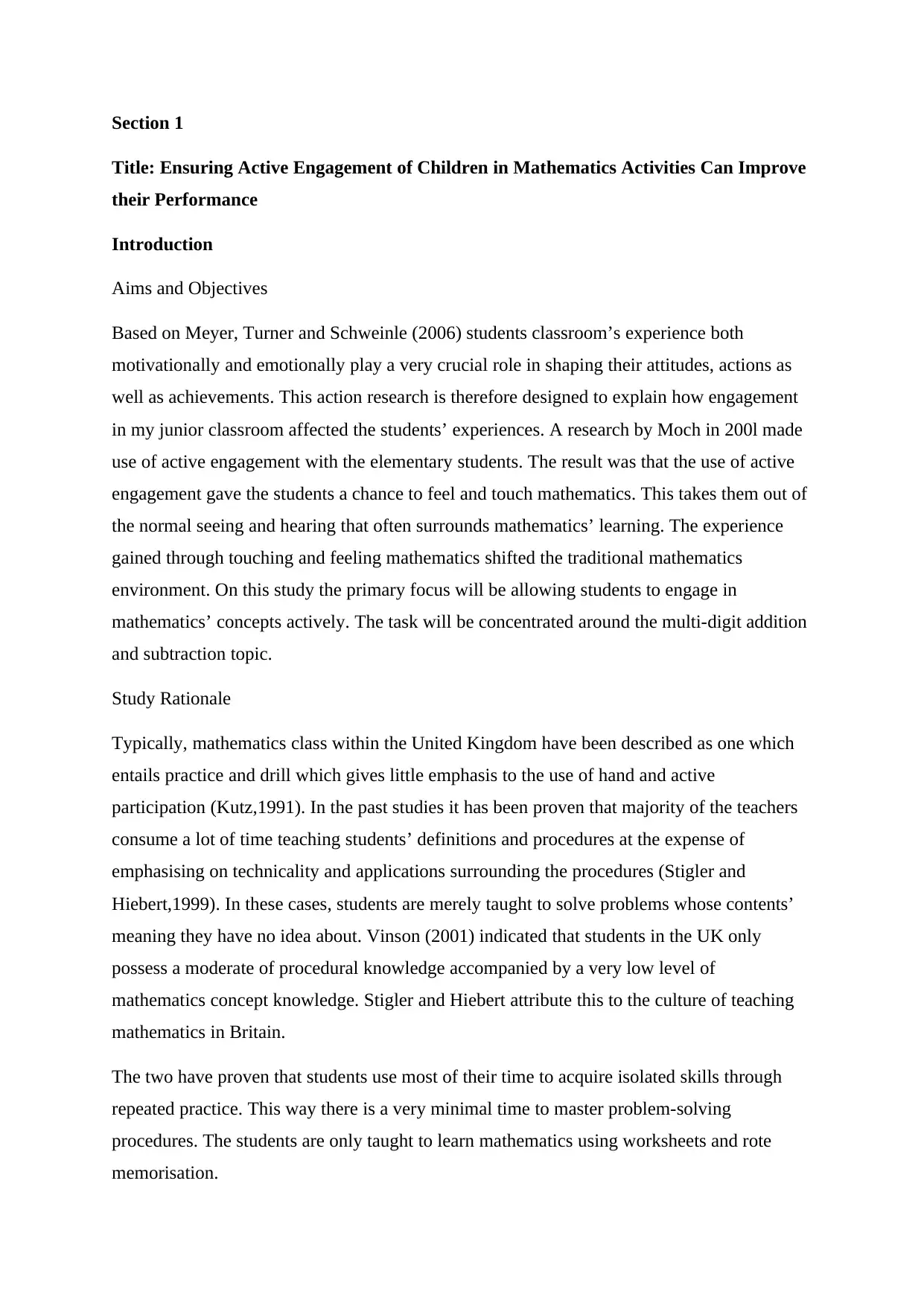
Section 1
Title: Ensuring Active Engagement of Children in Mathematics Activities Can Improve
their Performance
Introduction
Aims and Objectives
Based on Meyer, Turner and Schweinle (2006) students classroom’s experience both
motivationally and emotionally play a very crucial role in shaping their attitudes, actions as
well as achievements. This action research is therefore designed to explain how engagement
in my junior classroom affected the students’ experiences. A research by Moch in 200l made
use of active engagement with the elementary students. The result was that the use of active
engagement gave the students a chance to feel and touch mathematics. This takes them out of
the normal seeing and hearing that often surrounds mathematics’ learning. The experience
gained through touching and feeling mathematics shifted the traditional mathematics
environment. On this study the primary focus will be allowing students to engage in
mathematics’ concepts actively. The task will be concentrated around the multi-digit addition
and subtraction topic.
Study Rationale
Typically, mathematics class within the United Kingdom have been described as one which
entails practice and drill which gives little emphasis to the use of hand and active
participation (Kutz,1991). In the past studies it has been proven that majority of the teachers
consume a lot of time teaching students’ definitions and procedures at the expense of
emphasising on technicality and applications surrounding the procedures (Stigler and
Hiebert,1999). In these cases, students are merely taught to solve problems whose contents’
meaning they have no idea about. Vinson (2001) indicated that students in the UK only
possess a moderate of procedural knowledge accompanied by a very low level of
mathematics concept knowledge. Stigler and Hiebert attribute this to the culture of teaching
mathematics in Britain.
The two have proven that students use most of their time to acquire isolated skills through
repeated practice. This way there is a very minimal time to master problem-solving
procedures. The students are only taught to learn mathematics using worksheets and rote
memorisation.
Title: Ensuring Active Engagement of Children in Mathematics Activities Can Improve
their Performance
Introduction
Aims and Objectives
Based on Meyer, Turner and Schweinle (2006) students classroom’s experience both
motivationally and emotionally play a very crucial role in shaping their attitudes, actions as
well as achievements. This action research is therefore designed to explain how engagement
in my junior classroom affected the students’ experiences. A research by Moch in 200l made
use of active engagement with the elementary students. The result was that the use of active
engagement gave the students a chance to feel and touch mathematics. This takes them out of
the normal seeing and hearing that often surrounds mathematics’ learning. The experience
gained through touching and feeling mathematics shifted the traditional mathematics
environment. On this study the primary focus will be allowing students to engage in
mathematics’ concepts actively. The task will be concentrated around the multi-digit addition
and subtraction topic.
Study Rationale
Typically, mathematics class within the United Kingdom have been described as one which
entails practice and drill which gives little emphasis to the use of hand and active
participation (Kutz,1991). In the past studies it has been proven that majority of the teachers
consume a lot of time teaching students’ definitions and procedures at the expense of
emphasising on technicality and applications surrounding the procedures (Stigler and
Hiebert,1999). In these cases, students are merely taught to solve problems whose contents’
meaning they have no idea about. Vinson (2001) indicated that students in the UK only
possess a moderate of procedural knowledge accompanied by a very low level of
mathematics concept knowledge. Stigler and Hiebert attribute this to the culture of teaching
mathematics in Britain.
The two have proven that students use most of their time to acquire isolated skills through
repeated practice. This way there is a very minimal time to master problem-solving
procedures. The students are only taught to learn mathematics using worksheets and rote
memorisation.
Paraphrase This Document
Need a fresh take? Get an instant paraphrase of this document with our AI Paraphraser
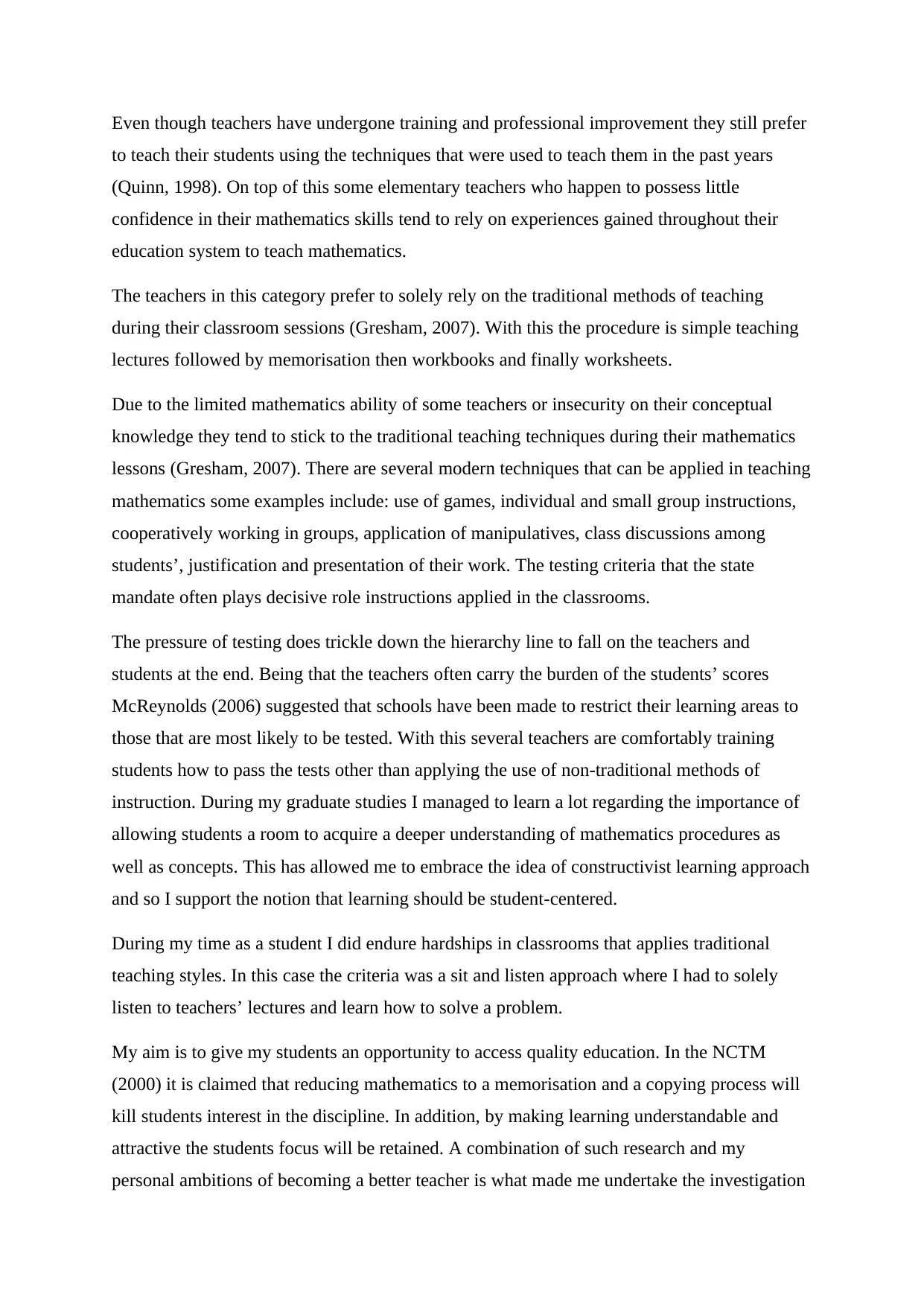
Even though teachers have undergone training and professional improvement they still prefer
to teach their students using the techniques that were used to teach them in the past years
(Quinn, 1998). On top of this some elementary teachers who happen to possess little
confidence in their mathematics skills tend to rely on experiences gained throughout their
education system to teach mathematics.
The teachers in this category prefer to solely rely on the traditional methods of teaching
during their classroom sessions (Gresham, 2007). With this the procedure is simple teaching
lectures followed by memorisation then workbooks and finally worksheets.
Due to the limited mathematics ability of some teachers or insecurity on their conceptual
knowledge they tend to stick to the traditional teaching techniques during their mathematics
lessons (Gresham, 2007). There are several modern techniques that can be applied in teaching
mathematics some examples include: use of games, individual and small group instructions,
cooperatively working in groups, application of manipulatives, class discussions among
students’, justification and presentation of their work. The testing criteria that the state
mandate often plays decisive role instructions applied in the classrooms.
The pressure of testing does trickle down the hierarchy line to fall on the teachers and
students at the end. Being that the teachers often carry the burden of the students’ scores
McReynolds (2006) suggested that schools have been made to restrict their learning areas to
those that are most likely to be tested. With this several teachers are comfortably training
students how to pass the tests other than applying the use of non-traditional methods of
instruction. During my graduate studies I managed to learn a lot regarding the importance of
allowing students a room to acquire a deeper understanding of mathematics procedures as
well as concepts. This has allowed me to embrace the idea of constructivist learning approach
and so I support the notion that learning should be student-centered.
During my time as a student I did endure hardships in classrooms that applies traditional
teaching styles. In this case the criteria was a sit and listen approach where I had to solely
listen to teachers’ lectures and learn how to solve a problem.
My aim is to give my students an opportunity to access quality education. In the NCTM
(2000) it is claimed that reducing mathematics to a memorisation and a copying process will
kill students interest in the discipline. In addition, by making learning understandable and
attractive the students focus will be retained. A combination of such research and my
personal ambitions of becoming a better teacher is what made me undertake the investigation
to teach their students using the techniques that were used to teach them in the past years
(Quinn, 1998). On top of this some elementary teachers who happen to possess little
confidence in their mathematics skills tend to rely on experiences gained throughout their
education system to teach mathematics.
The teachers in this category prefer to solely rely on the traditional methods of teaching
during their classroom sessions (Gresham, 2007). With this the procedure is simple teaching
lectures followed by memorisation then workbooks and finally worksheets.
Due to the limited mathematics ability of some teachers or insecurity on their conceptual
knowledge they tend to stick to the traditional teaching techniques during their mathematics
lessons (Gresham, 2007). There are several modern techniques that can be applied in teaching
mathematics some examples include: use of games, individual and small group instructions,
cooperatively working in groups, application of manipulatives, class discussions among
students’, justification and presentation of their work. The testing criteria that the state
mandate often plays decisive role instructions applied in the classrooms.
The pressure of testing does trickle down the hierarchy line to fall on the teachers and
students at the end. Being that the teachers often carry the burden of the students’ scores
McReynolds (2006) suggested that schools have been made to restrict their learning areas to
those that are most likely to be tested. With this several teachers are comfortably training
students how to pass the tests other than applying the use of non-traditional methods of
instruction. During my graduate studies I managed to learn a lot regarding the importance of
allowing students a room to acquire a deeper understanding of mathematics procedures as
well as concepts. This has allowed me to embrace the idea of constructivist learning approach
and so I support the notion that learning should be student-centered.
During my time as a student I did endure hardships in classrooms that applies traditional
teaching styles. In this case the criteria was a sit and listen approach where I had to solely
listen to teachers’ lectures and learn how to solve a problem.
My aim is to give my students an opportunity to access quality education. In the NCTM
(2000) it is claimed that reducing mathematics to a memorisation and a copying process will
kill students interest in the discipline. In addition, by making learning understandable and
attractive the students focus will be retained. A combination of such research and my
personal ambitions of becoming a better teacher is what made me undertake the investigation
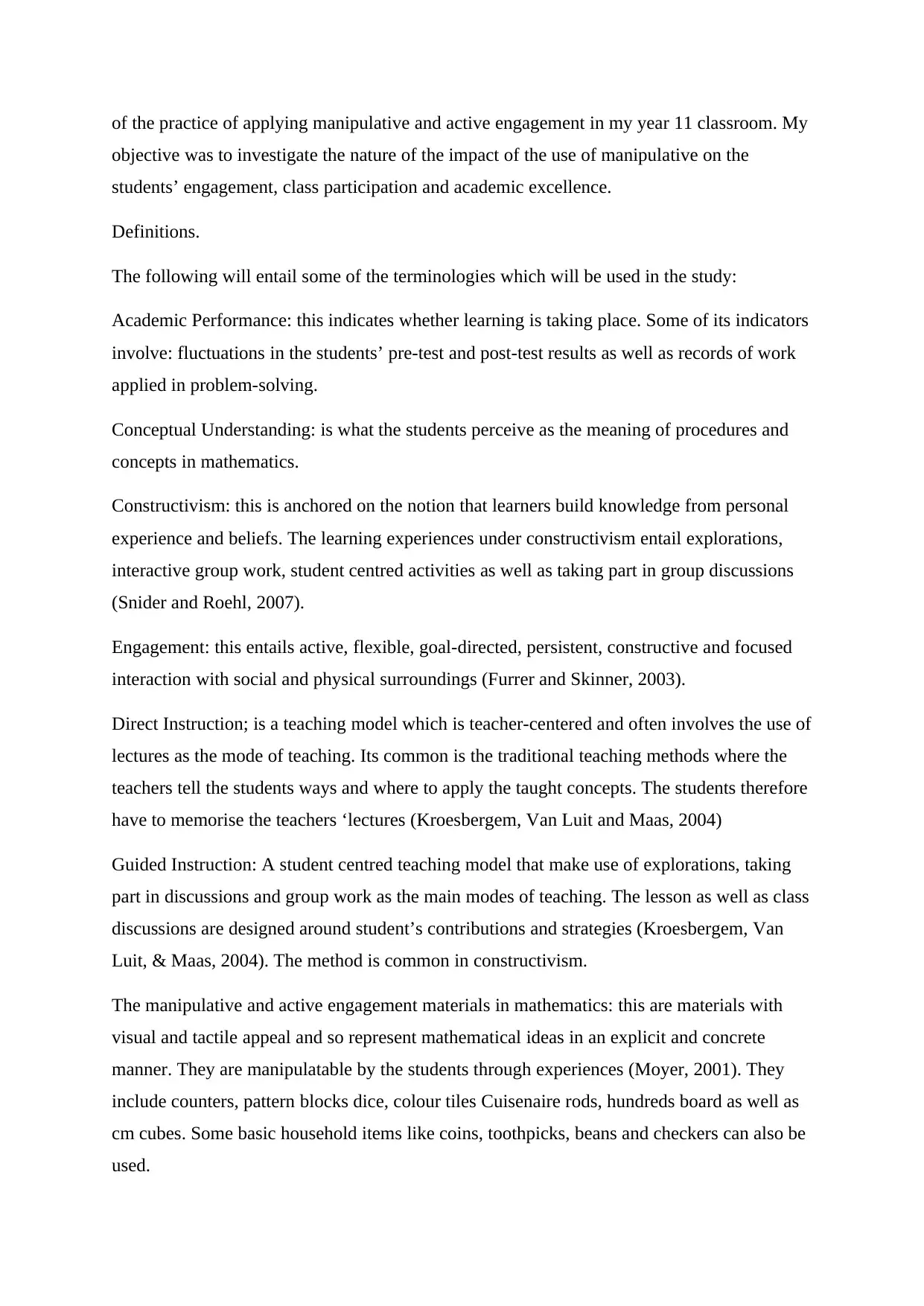
of the practice of applying manipulative and active engagement in my year 11 classroom. My
objective was to investigate the nature of the impact of the use of manipulative on the
students’ engagement, class participation and academic excellence.
Definitions.
The following will entail some of the terminologies which will be used in the study:
Academic Performance: this indicates whether learning is taking place. Some of its indicators
involve: fluctuations in the students’ pre-test and post-test results as well as records of work
applied in problem-solving.
Conceptual Understanding: is what the students perceive as the meaning of procedures and
concepts in mathematics.
Constructivism: this is anchored on the notion that learners build knowledge from personal
experience and beliefs. The learning experiences under constructivism entail explorations,
interactive group work, student centred activities as well as taking part in group discussions
(Snider and Roehl, 2007).
Engagement: this entails active, flexible, goal-directed, persistent, constructive and focused
interaction with social and physical surroundings (Furrer and Skinner, 2003).
Direct Instruction; is a teaching model which is teacher-centered and often involves the use of
lectures as the mode of teaching. Its common is the traditional teaching methods where the
teachers tell the students ways and where to apply the taught concepts. The students therefore
have to memorise the teachers ‘lectures (Kroesbergem, Van Luit and Maas, 2004)
Guided Instruction: A student centred teaching model that make use of explorations, taking
part in discussions and group work as the main modes of teaching. The lesson as well as class
discussions are designed around student’s contributions and strategies (Kroesbergem, Van
Luit, & Maas, 2004). The method is common in constructivism.
The manipulative and active engagement materials in mathematics: this are materials with
visual and tactile appeal and so represent mathematical ideas in an explicit and concrete
manner. They are manipulatable by the students through experiences (Moyer, 2001). They
include counters, pattern blocks dice, colour tiles Cuisenaire rods, hundreds board as well as
cm cubes. Some basic household items like coins, toothpicks, beans and checkers can also be
used.
objective was to investigate the nature of the impact of the use of manipulative on the
students’ engagement, class participation and academic excellence.
Definitions.
The following will entail some of the terminologies which will be used in the study:
Academic Performance: this indicates whether learning is taking place. Some of its indicators
involve: fluctuations in the students’ pre-test and post-test results as well as records of work
applied in problem-solving.
Conceptual Understanding: is what the students perceive as the meaning of procedures and
concepts in mathematics.
Constructivism: this is anchored on the notion that learners build knowledge from personal
experience and beliefs. The learning experiences under constructivism entail explorations,
interactive group work, student centred activities as well as taking part in group discussions
(Snider and Roehl, 2007).
Engagement: this entails active, flexible, goal-directed, persistent, constructive and focused
interaction with social and physical surroundings (Furrer and Skinner, 2003).
Direct Instruction; is a teaching model which is teacher-centered and often involves the use of
lectures as the mode of teaching. Its common is the traditional teaching methods where the
teachers tell the students ways and where to apply the taught concepts. The students therefore
have to memorise the teachers ‘lectures (Kroesbergem, Van Luit and Maas, 2004)
Guided Instruction: A student centred teaching model that make use of explorations, taking
part in discussions and group work as the main modes of teaching. The lesson as well as class
discussions are designed around student’s contributions and strategies (Kroesbergem, Van
Luit, & Maas, 2004). The method is common in constructivism.
The manipulative and active engagement materials in mathematics: this are materials with
visual and tactile appeal and so represent mathematical ideas in an explicit and concrete
manner. They are manipulatable by the students through experiences (Moyer, 2001). They
include counters, pattern blocks dice, colour tiles Cuisenaire rods, hundreds board as well as
cm cubes. Some basic household items like coins, toothpicks, beans and checkers can also be
used.
⊘ This is a preview!⊘
Do you want full access?
Subscribe today to unlock all pages.

Trusted by 1+ million students worldwide
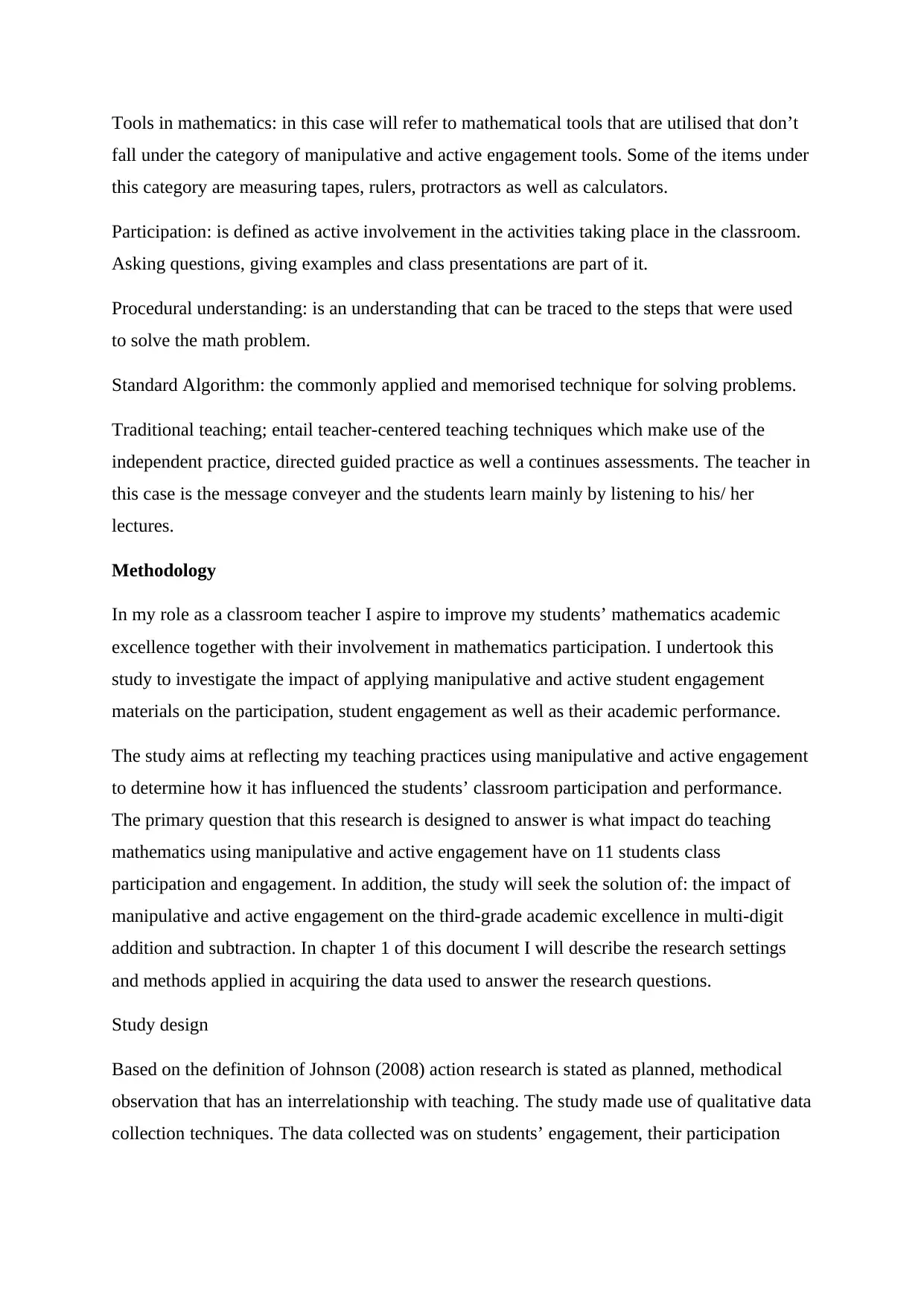
Tools in mathematics: in this case will refer to mathematical tools that are utilised that don’t
fall under the category of manipulative and active engagement tools. Some of the items under
this category are measuring tapes, rulers, protractors as well as calculators.
Participation: is defined as active involvement in the activities taking place in the classroom.
Asking questions, giving examples and class presentations are part of it.
Procedural understanding: is an understanding that can be traced to the steps that were used
to solve the math problem.
Standard Algorithm: the commonly applied and memorised technique for solving problems.
Traditional teaching; entail teacher-centered teaching techniques which make use of the
independent practice, directed guided practice as well a continues assessments. The teacher in
this case is the message conveyer and the students learn mainly by listening to his/ her
lectures.
Methodology
In my role as a classroom teacher I aspire to improve my students’ mathematics academic
excellence together with their involvement in mathematics participation. I undertook this
study to investigate the impact of applying manipulative and active student engagement
materials on the participation, student engagement as well as their academic performance.
The study aims at reflecting my teaching practices using manipulative and active engagement
to determine how it has influenced the students’ classroom participation and performance.
The primary question that this research is designed to answer is what impact do teaching
mathematics using manipulative and active engagement have on 11 students class
participation and engagement. In addition, the study will seek the solution of: the impact of
manipulative and active engagement on the third-grade academic excellence in multi-digit
addition and subtraction. In chapter 1 of this document I will describe the research settings
and methods applied in acquiring the data used to answer the research questions.
Study design
Based on the definition of Johnson (2008) action research is stated as planned, methodical
observation that has an interrelationship with teaching. The study made use of qualitative data
collection techniques. The data collected was on students’ engagement, their participation
fall under the category of manipulative and active engagement tools. Some of the items under
this category are measuring tapes, rulers, protractors as well as calculators.
Participation: is defined as active involvement in the activities taking place in the classroom.
Asking questions, giving examples and class presentations are part of it.
Procedural understanding: is an understanding that can be traced to the steps that were used
to solve the math problem.
Standard Algorithm: the commonly applied and memorised technique for solving problems.
Traditional teaching; entail teacher-centered teaching techniques which make use of the
independent practice, directed guided practice as well a continues assessments. The teacher in
this case is the message conveyer and the students learn mainly by listening to his/ her
lectures.
Methodology
In my role as a classroom teacher I aspire to improve my students’ mathematics academic
excellence together with their involvement in mathematics participation. I undertook this
study to investigate the impact of applying manipulative and active student engagement
materials on the participation, student engagement as well as their academic performance.
The study aims at reflecting my teaching practices using manipulative and active engagement
to determine how it has influenced the students’ classroom participation and performance.
The primary question that this research is designed to answer is what impact do teaching
mathematics using manipulative and active engagement have on 11 students class
participation and engagement. In addition, the study will seek the solution of: the impact of
manipulative and active engagement on the third-grade academic excellence in multi-digit
addition and subtraction. In chapter 1 of this document I will describe the research settings
and methods applied in acquiring the data used to answer the research questions.
Study design
Based on the definition of Johnson (2008) action research is stated as planned, methodical
observation that has an interrelationship with teaching. The study made use of qualitative data
collection techniques. The data collected was on students’ engagement, their participation
Paraphrase This Document
Need a fresh take? Get an instant paraphrase of this document with our AI Paraphraser
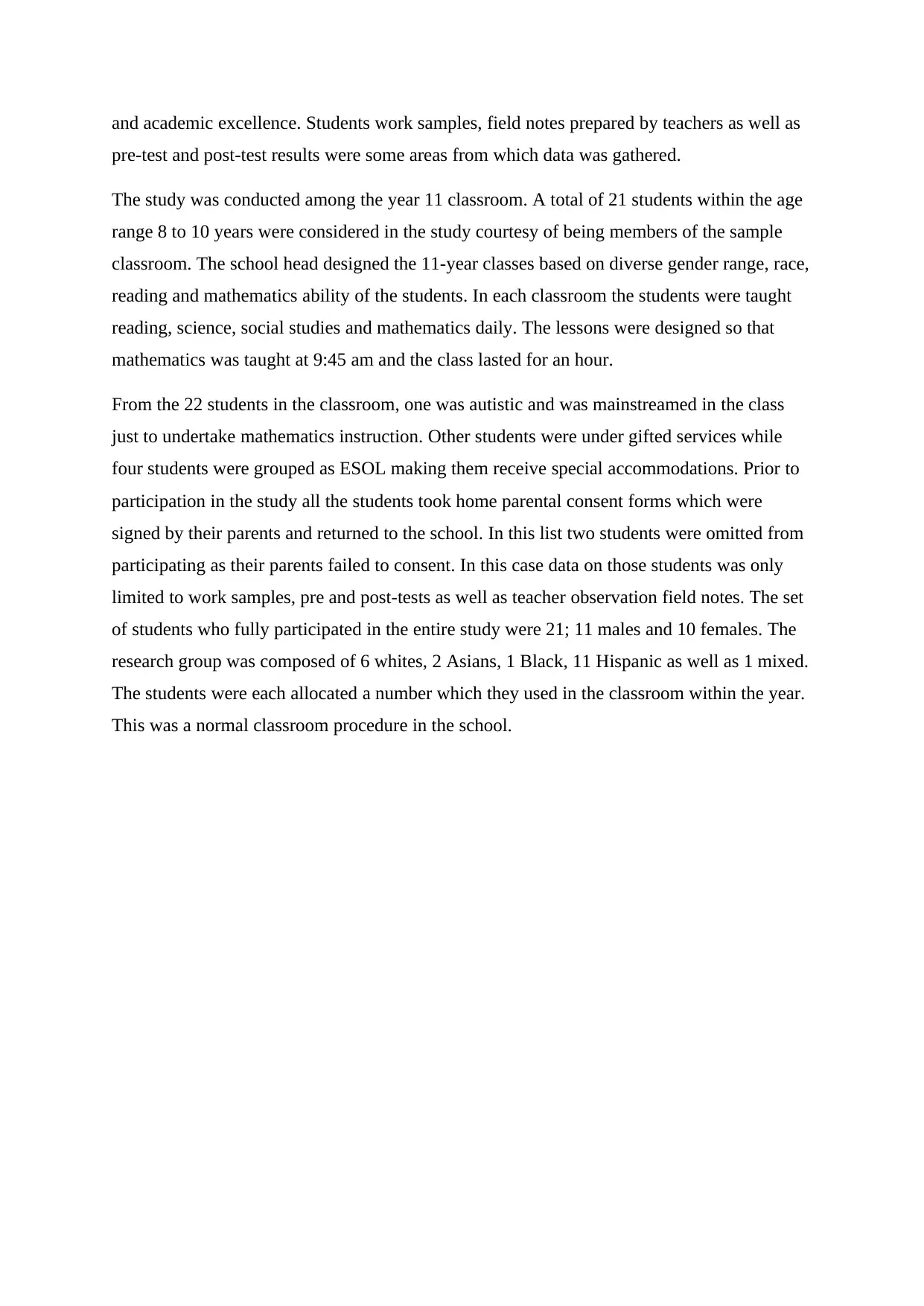
and academic excellence. Students work samples, field notes prepared by teachers as well as
pre-test and post-test results were some areas from which data was gathered.
The study was conducted among the year 11 classroom. A total of 21 students within the age
range 8 to 10 years were considered in the study courtesy of being members of the sample
classroom. The school head designed the 11-year classes based on diverse gender range, race,
reading and mathematics ability of the students. In each classroom the students were taught
reading, science, social studies and mathematics daily. The lessons were designed so that
mathematics was taught at 9:45 am and the class lasted for an hour.
From the 22 students in the classroom, one was autistic and was mainstreamed in the class
just to undertake mathematics instruction. Other students were under gifted services while
four students were grouped as ESOL making them receive special accommodations. Prior to
participation in the study all the students took home parental consent forms which were
signed by their parents and returned to the school. In this list two students were omitted from
participating as their parents failed to consent. In this case data on those students was only
limited to work samples, pre and post-tests as well as teacher observation field notes. The set
of students who fully participated in the entire study were 21; 11 males and 10 females. The
research group was composed of 6 whites, 2 Asians, 1 Black, 11 Hispanic as well as 1 mixed.
The students were each allocated a number which they used in the classroom within the year.
This was a normal classroom procedure in the school.
pre-test and post-test results were some areas from which data was gathered.
The study was conducted among the year 11 classroom. A total of 21 students within the age
range 8 to 10 years were considered in the study courtesy of being members of the sample
classroom. The school head designed the 11-year classes based on diverse gender range, race,
reading and mathematics ability of the students. In each classroom the students were taught
reading, science, social studies and mathematics daily. The lessons were designed so that
mathematics was taught at 9:45 am and the class lasted for an hour.
From the 22 students in the classroom, one was autistic and was mainstreamed in the class
just to undertake mathematics instruction. Other students were under gifted services while
four students were grouped as ESOL making them receive special accommodations. Prior to
participation in the study all the students took home parental consent forms which were
signed by their parents and returned to the school. In this list two students were omitted from
participating as their parents failed to consent. In this case data on those students was only
limited to work samples, pre and post-tests as well as teacher observation field notes. The set
of students who fully participated in the entire study were 21; 11 males and 10 females. The
research group was composed of 6 whites, 2 Asians, 1 Black, 11 Hispanic as well as 1 mixed.
The students were each allocated a number which they used in the classroom within the year.
This was a normal classroom procedure in the school.
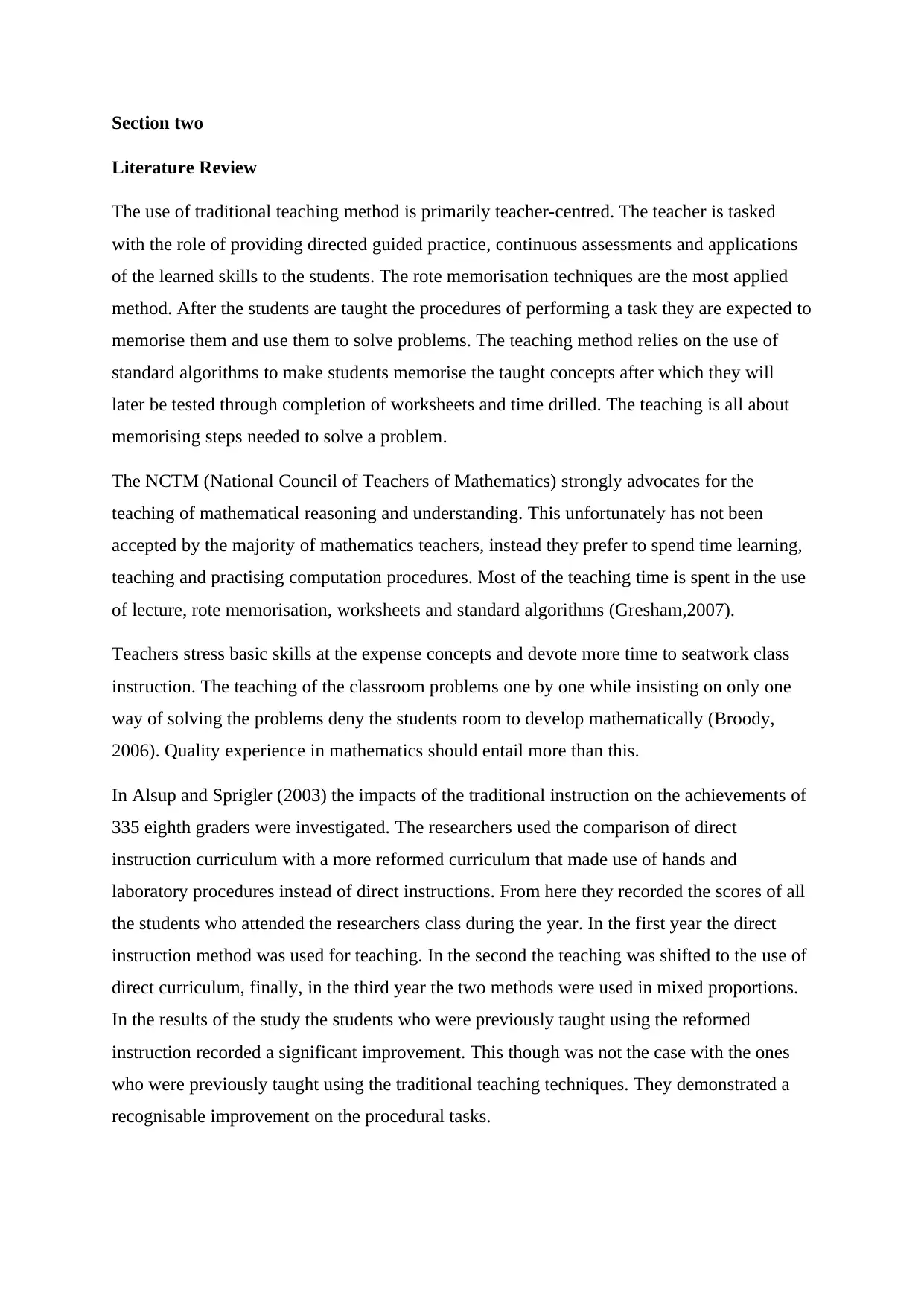
Section two
Literature Review
The use of traditional teaching method is primarily teacher-centred. The teacher is tasked
with the role of providing directed guided practice, continuous assessments and applications
of the learned skills to the students. The rote memorisation techniques are the most applied
method. After the students are taught the procedures of performing a task they are expected to
memorise them and use them to solve problems. The teaching method relies on the use of
standard algorithms to make students memorise the taught concepts after which they will
later be tested through completion of worksheets and time drilled. The teaching is all about
memorising steps needed to solve a problem.
The NCTM (National Council of Teachers of Mathematics) strongly advocates for the
teaching of mathematical reasoning and understanding. This unfortunately has not been
accepted by the majority of mathematics teachers, instead they prefer to spend time learning,
teaching and practising computation procedures. Most of the teaching time is spent in the use
of lecture, rote memorisation, worksheets and standard algorithms (Gresham,2007).
Teachers stress basic skills at the expense concepts and devote more time to seatwork class
instruction. The teaching of the classroom problems one by one while insisting on only one
way of solving the problems deny the students room to develop mathematically (Broody,
2006). Quality experience in mathematics should entail more than this.
In Alsup and Sprigler (2003) the impacts of the traditional instruction on the achievements of
335 eighth graders were investigated. The researchers used the comparison of direct
instruction curriculum with a more reformed curriculum that made use of hands and
laboratory procedures instead of direct instructions. From here they recorded the scores of all
the students who attended the researchers class during the year. In the first year the direct
instruction method was used for teaching. In the second the teaching was shifted to the use of
direct curriculum, finally, in the third year the two methods were used in mixed proportions.
In the results of the study the students who were previously taught using the reformed
instruction recorded a significant improvement. This though was not the case with the ones
who were previously taught using the traditional teaching techniques. They demonstrated a
recognisable improvement on the procedural tasks.
Literature Review
The use of traditional teaching method is primarily teacher-centred. The teacher is tasked
with the role of providing directed guided practice, continuous assessments and applications
of the learned skills to the students. The rote memorisation techniques are the most applied
method. After the students are taught the procedures of performing a task they are expected to
memorise them and use them to solve problems. The teaching method relies on the use of
standard algorithms to make students memorise the taught concepts after which they will
later be tested through completion of worksheets and time drilled. The teaching is all about
memorising steps needed to solve a problem.
The NCTM (National Council of Teachers of Mathematics) strongly advocates for the
teaching of mathematical reasoning and understanding. This unfortunately has not been
accepted by the majority of mathematics teachers, instead they prefer to spend time learning,
teaching and practising computation procedures. Most of the teaching time is spent in the use
of lecture, rote memorisation, worksheets and standard algorithms (Gresham,2007).
Teachers stress basic skills at the expense concepts and devote more time to seatwork class
instruction. The teaching of the classroom problems one by one while insisting on only one
way of solving the problems deny the students room to develop mathematically (Broody,
2006). Quality experience in mathematics should entail more than this.
In Alsup and Sprigler (2003) the impacts of the traditional instruction on the achievements of
335 eighth graders were investigated. The researchers used the comparison of direct
instruction curriculum with a more reformed curriculum that made use of hands and
laboratory procedures instead of direct instructions. From here they recorded the scores of all
the students who attended the researchers class during the year. In the first year the direct
instruction method was used for teaching. In the second the teaching was shifted to the use of
direct curriculum, finally, in the third year the two methods were used in mixed proportions.
In the results of the study the students who were previously taught using the reformed
instruction recorded a significant improvement. This though was not the case with the ones
who were previously taught using the traditional teaching techniques. They demonstrated a
recognisable improvement on the procedural tasks.
⊘ This is a preview!⊘
Do you want full access?
Subscribe today to unlock all pages.

Trusted by 1+ million students worldwide
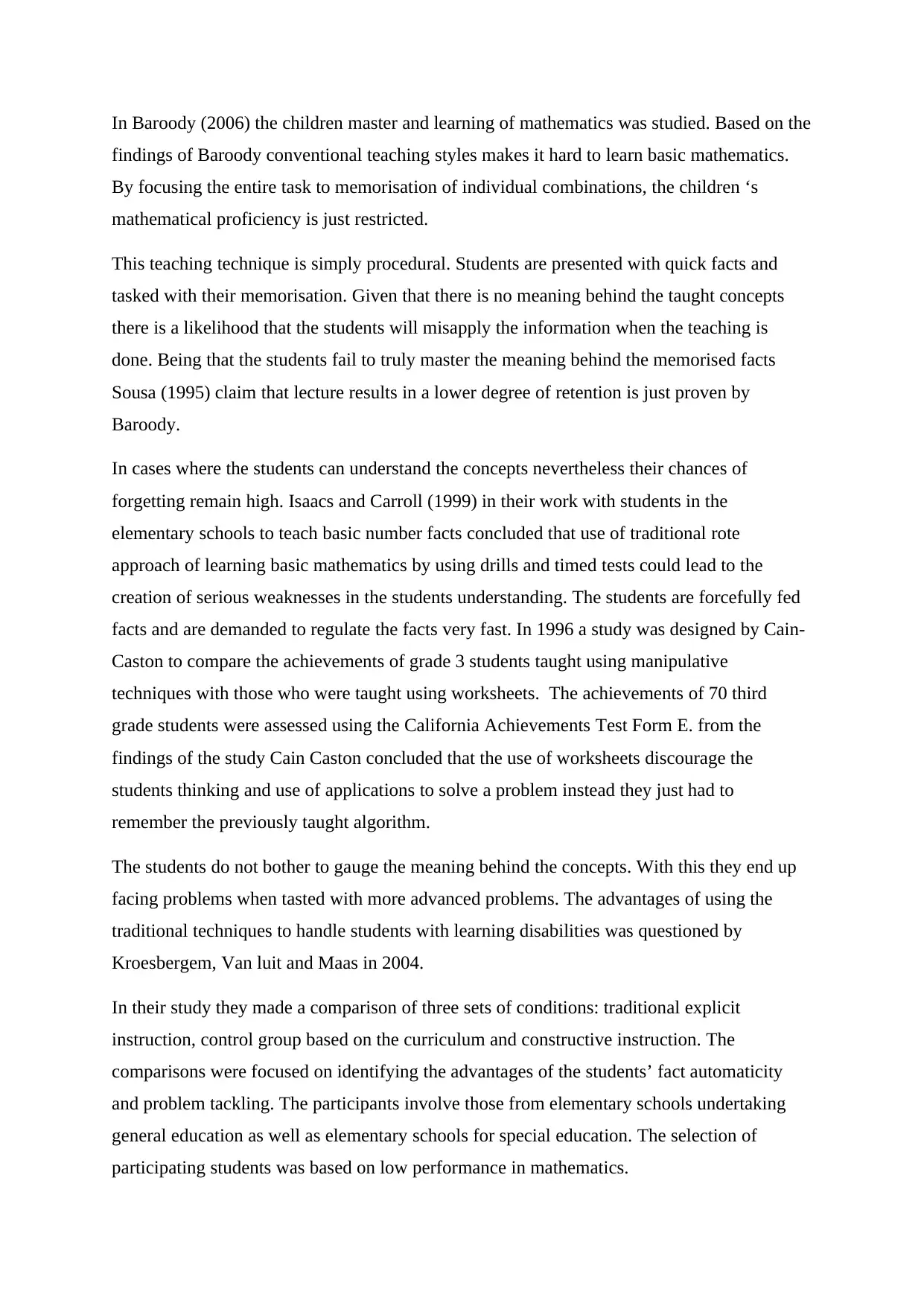
In Baroody (2006) the children master and learning of mathematics was studied. Based on the
findings of Baroody conventional teaching styles makes it hard to learn basic mathematics.
By focusing the entire task to memorisation of individual combinations, the children ‘s
mathematical proficiency is just restricted.
This teaching technique is simply procedural. Students are presented with quick facts and
tasked with their memorisation. Given that there is no meaning behind the taught concepts
there is a likelihood that the students will misapply the information when the teaching is
done. Being that the students fail to truly master the meaning behind the memorised facts
Sousa (1995) claim that lecture results in a lower degree of retention is just proven by
Baroody.
In cases where the students can understand the concepts nevertheless their chances of
forgetting remain high. Isaacs and Carroll (1999) in their work with students in the
elementary schools to teach basic number facts concluded that use of traditional rote
approach of learning basic mathematics by using drills and timed tests could lead to the
creation of serious weaknesses in the students understanding. The students are forcefully fed
facts and are demanded to regulate the facts very fast. In 1996 a study was designed by Cain-
Caston to compare the achievements of grade 3 students taught using manipulative
techniques with those who were taught using worksheets. The achievements of 70 third
grade students were assessed using the California Achievements Test Form E. from the
findings of the study Cain Caston concluded that the use of worksheets discourage the
students thinking and use of applications to solve a problem instead they just had to
remember the previously taught algorithm.
The students do not bother to gauge the meaning behind the concepts. With this they end up
facing problems when tasted with more advanced problems. The advantages of using the
traditional techniques to handle students with learning disabilities was questioned by
Kroesbergem, Van luit and Maas in 2004.
In their study they made a comparison of three sets of conditions: traditional explicit
instruction, control group based on the curriculum and constructive instruction. The
comparisons were focused on identifying the advantages of the students’ fact automaticity
and problem tackling. The participants involve those from elementary schools undertaking
general education as well as elementary schools for special education. The selection of
participating students was based on low performance in mathematics.
findings of Baroody conventional teaching styles makes it hard to learn basic mathematics.
By focusing the entire task to memorisation of individual combinations, the children ‘s
mathematical proficiency is just restricted.
This teaching technique is simply procedural. Students are presented with quick facts and
tasked with their memorisation. Given that there is no meaning behind the taught concepts
there is a likelihood that the students will misapply the information when the teaching is
done. Being that the students fail to truly master the meaning behind the memorised facts
Sousa (1995) claim that lecture results in a lower degree of retention is just proven by
Baroody.
In cases where the students can understand the concepts nevertheless their chances of
forgetting remain high. Isaacs and Carroll (1999) in their work with students in the
elementary schools to teach basic number facts concluded that use of traditional rote
approach of learning basic mathematics by using drills and timed tests could lead to the
creation of serious weaknesses in the students understanding. The students are forcefully fed
facts and are demanded to regulate the facts very fast. In 1996 a study was designed by Cain-
Caston to compare the achievements of grade 3 students taught using manipulative
techniques with those who were taught using worksheets. The achievements of 70 third
grade students were assessed using the California Achievements Test Form E. from the
findings of the study Cain Caston concluded that the use of worksheets discourage the
students thinking and use of applications to solve a problem instead they just had to
remember the previously taught algorithm.
The students do not bother to gauge the meaning behind the concepts. With this they end up
facing problems when tasted with more advanced problems. The advantages of using the
traditional techniques to handle students with learning disabilities was questioned by
Kroesbergem, Van luit and Maas in 2004.
In their study they made a comparison of three sets of conditions: traditional explicit
instruction, control group based on the curriculum and constructive instruction. The
comparisons were focused on identifying the advantages of the students’ fact automaticity
and problem tackling. The participants involve those from elementary schools undertaking
general education as well as elementary schools for special education. The selection of
participating students was based on low performance in mathematics.
Paraphrase This Document
Need a fresh take? Get an instant paraphrase of this document with our AI Paraphraser
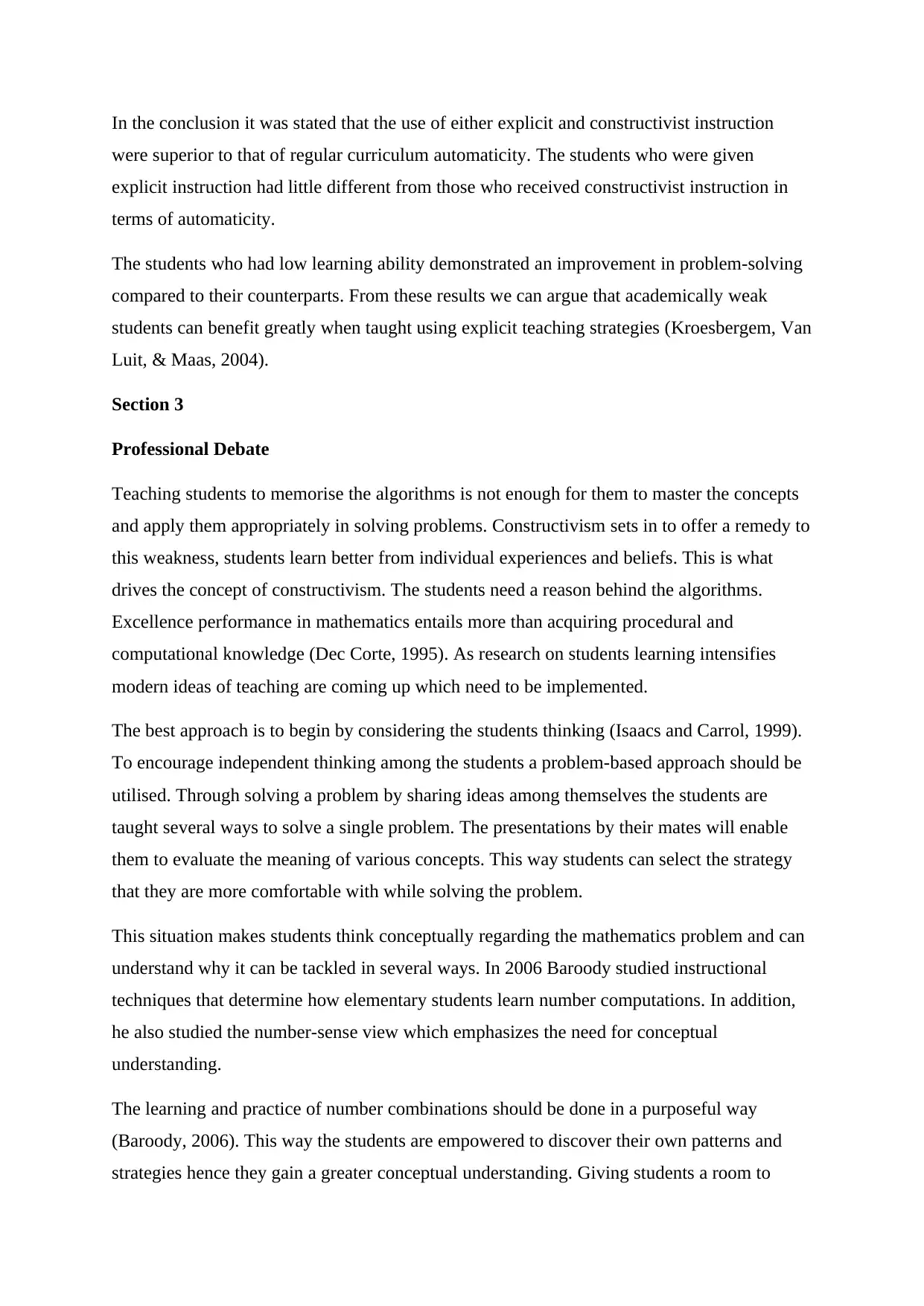
In the conclusion it was stated that the use of either explicit and constructivist instruction
were superior to that of regular curriculum automaticity. The students who were given
explicit instruction had little different from those who received constructivist instruction in
terms of automaticity.
The students who had low learning ability demonstrated an improvement in problem-solving
compared to their counterparts. From these results we can argue that academically weak
students can benefit greatly when taught using explicit teaching strategies (Kroesbergem, Van
Luit, & Maas, 2004).
Section 3
Professional Debate
Teaching students to memorise the algorithms is not enough for them to master the concepts
and apply them appropriately in solving problems. Constructivism sets in to offer a remedy to
this weakness, students learn better from individual experiences and beliefs. This is what
drives the concept of constructivism. The students need a reason behind the algorithms.
Excellence performance in mathematics entails more than acquiring procedural and
computational knowledge (Dec Corte, 1995). As research on students learning intensifies
modern ideas of teaching are coming up which need to be implemented.
The best approach is to begin by considering the students thinking (Isaacs and Carrol, 1999).
To encourage independent thinking among the students a problem-based approach should be
utilised. Through solving a problem by sharing ideas among themselves the students are
taught several ways to solve a single problem. The presentations by their mates will enable
them to evaluate the meaning of various concepts. This way students can select the strategy
that they are more comfortable with while solving the problem.
This situation makes students think conceptually regarding the mathematics problem and can
understand why it can be tackled in several ways. In 2006 Baroody studied instructional
techniques that determine how elementary students learn number computations. In addition,
he also studied the number-sense view which emphasizes the need for conceptual
understanding.
The learning and practice of number combinations should be done in a purposeful way
(Baroody, 2006). This way the students are empowered to discover their own patterns and
strategies hence they gain a greater conceptual understanding. Giving students a room to
were superior to that of regular curriculum automaticity. The students who were given
explicit instruction had little different from those who received constructivist instruction in
terms of automaticity.
The students who had low learning ability demonstrated an improvement in problem-solving
compared to their counterparts. From these results we can argue that academically weak
students can benefit greatly when taught using explicit teaching strategies (Kroesbergem, Van
Luit, & Maas, 2004).
Section 3
Professional Debate
Teaching students to memorise the algorithms is not enough for them to master the concepts
and apply them appropriately in solving problems. Constructivism sets in to offer a remedy to
this weakness, students learn better from individual experiences and beliefs. This is what
drives the concept of constructivism. The students need a reason behind the algorithms.
Excellence performance in mathematics entails more than acquiring procedural and
computational knowledge (Dec Corte, 1995). As research on students learning intensifies
modern ideas of teaching are coming up which need to be implemented.
The best approach is to begin by considering the students thinking (Isaacs and Carrol, 1999).
To encourage independent thinking among the students a problem-based approach should be
utilised. Through solving a problem by sharing ideas among themselves the students are
taught several ways to solve a single problem. The presentations by their mates will enable
them to evaluate the meaning of various concepts. This way students can select the strategy
that they are more comfortable with while solving the problem.
This situation makes students think conceptually regarding the mathematics problem and can
understand why it can be tackled in several ways. In 2006 Baroody studied instructional
techniques that determine how elementary students learn number computations. In addition,
he also studied the number-sense view which emphasizes the need for conceptual
understanding.
The learning and practice of number combinations should be done in a purposeful way
(Baroody, 2006). This way the students are empowered to discover their own patterns and
strategies hence they gain a greater conceptual understanding. Giving students a room to
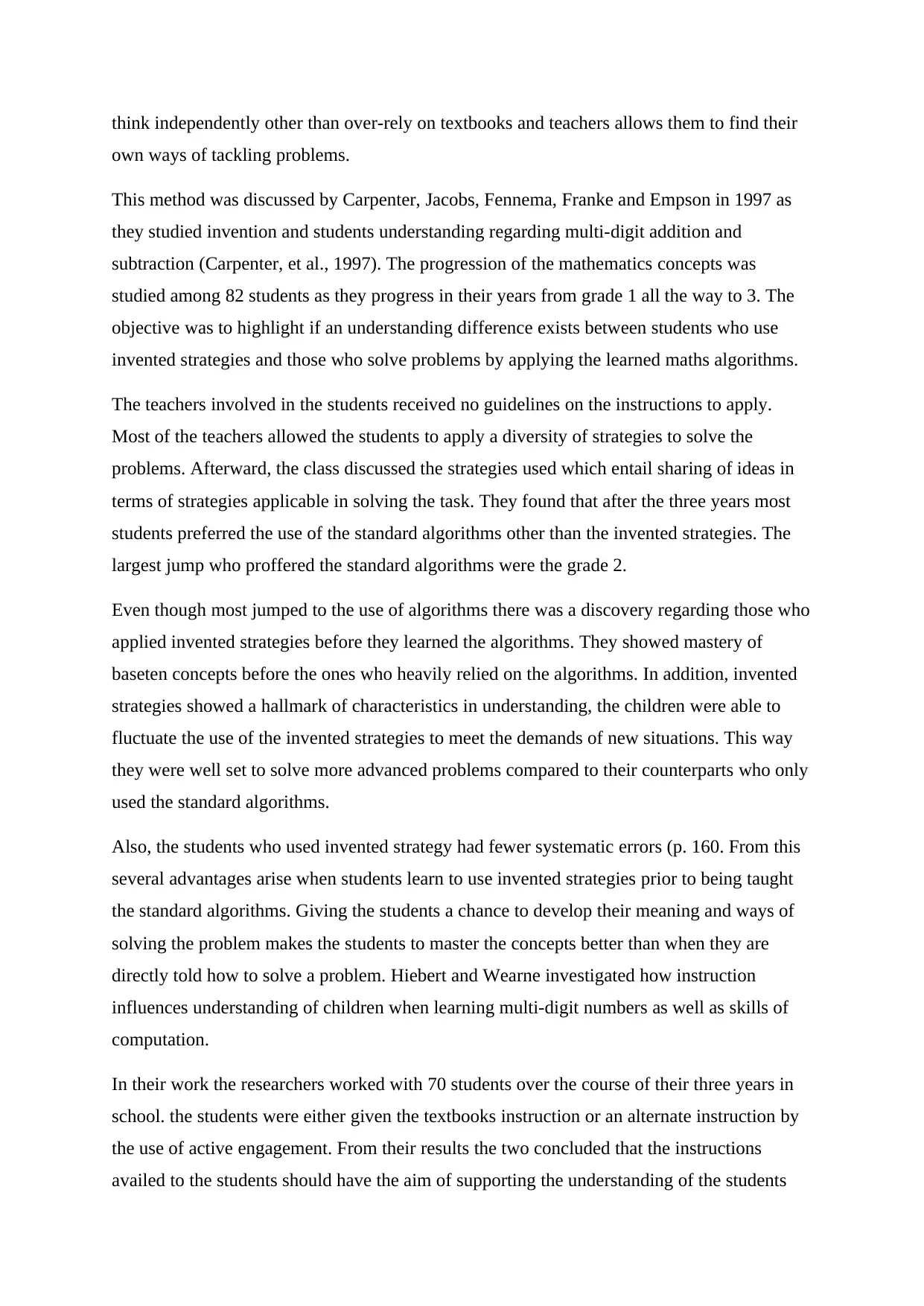
think independently other than over-rely on textbooks and teachers allows them to find their
own ways of tackling problems.
This method was discussed by Carpenter, Jacobs, Fennema, Franke and Empson in 1997 as
they studied invention and students understanding regarding multi-digit addition and
subtraction (Carpenter, et al., 1997). The progression of the mathematics concepts was
studied among 82 students as they progress in their years from grade 1 all the way to 3. The
objective was to highlight if an understanding difference exists between students who use
invented strategies and those who solve problems by applying the learned maths algorithms.
The teachers involved in the students received no guidelines on the instructions to apply.
Most of the teachers allowed the students to apply a diversity of strategies to solve the
problems. Afterward, the class discussed the strategies used which entail sharing of ideas in
terms of strategies applicable in solving the task. They found that after the three years most
students preferred the use of the standard algorithms other than the invented strategies. The
largest jump who proffered the standard algorithms were the grade 2.
Even though most jumped to the use of algorithms there was a discovery regarding those who
applied invented strategies before they learned the algorithms. They showed mastery of
baseten concepts before the ones who heavily relied on the algorithms. In addition, invented
strategies showed a hallmark of characteristics in understanding, the children were able to
fluctuate the use of the invented strategies to meet the demands of new situations. This way
they were well set to solve more advanced problems compared to their counterparts who only
used the standard algorithms.
Also, the students who used invented strategy had fewer systematic errors (p. 160. From this
several advantages arise when students learn to use invented strategies prior to being taught
the standard algorithms. Giving the students a chance to develop their meaning and ways of
solving the problem makes the students to master the concepts better than when they are
directly told how to solve a problem. Hiebert and Wearne investigated how instruction
influences understanding of children when learning multi-digit numbers as well as skills of
computation.
In their work the researchers worked with 70 students over the course of their three years in
school. the students were either given the textbooks instruction or an alternate instruction by
the use of active engagement. From their results the two concluded that the instructions
availed to the students should have the aim of supporting the understanding of the students
own ways of tackling problems.
This method was discussed by Carpenter, Jacobs, Fennema, Franke and Empson in 1997 as
they studied invention and students understanding regarding multi-digit addition and
subtraction (Carpenter, et al., 1997). The progression of the mathematics concepts was
studied among 82 students as they progress in their years from grade 1 all the way to 3. The
objective was to highlight if an understanding difference exists between students who use
invented strategies and those who solve problems by applying the learned maths algorithms.
The teachers involved in the students received no guidelines on the instructions to apply.
Most of the teachers allowed the students to apply a diversity of strategies to solve the
problems. Afterward, the class discussed the strategies used which entail sharing of ideas in
terms of strategies applicable in solving the task. They found that after the three years most
students preferred the use of the standard algorithms other than the invented strategies. The
largest jump who proffered the standard algorithms were the grade 2.
Even though most jumped to the use of algorithms there was a discovery regarding those who
applied invented strategies before they learned the algorithms. They showed mastery of
baseten concepts before the ones who heavily relied on the algorithms. In addition, invented
strategies showed a hallmark of characteristics in understanding, the children were able to
fluctuate the use of the invented strategies to meet the demands of new situations. This way
they were well set to solve more advanced problems compared to their counterparts who only
used the standard algorithms.
Also, the students who used invented strategy had fewer systematic errors (p. 160. From this
several advantages arise when students learn to use invented strategies prior to being taught
the standard algorithms. Giving the students a chance to develop their meaning and ways of
solving the problem makes the students to master the concepts better than when they are
directly told how to solve a problem. Hiebert and Wearne investigated how instruction
influences understanding of children when learning multi-digit numbers as well as skills of
computation.
In their work the researchers worked with 70 students over the course of their three years in
school. the students were either given the textbooks instruction or an alternate instruction by
the use of active engagement. From their results the two concluded that the instructions
availed to the students should have the aim of supporting the understanding of the students
⊘ This is a preview!⊘
Do you want full access?
Subscribe today to unlock all pages.

Trusted by 1+ million students worldwide
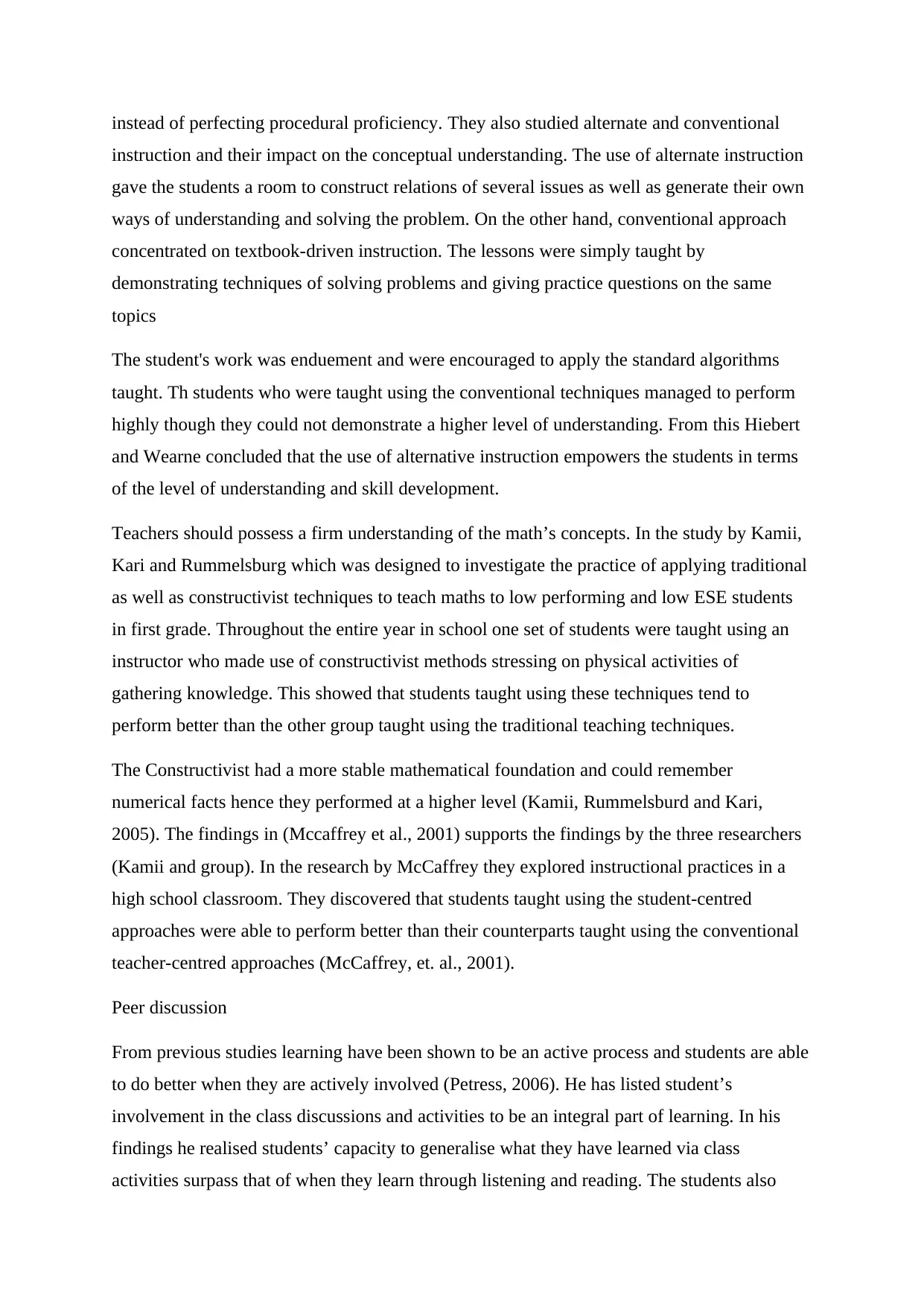
instead of perfecting procedural proficiency. They also studied alternate and conventional
instruction and their impact on the conceptual understanding. The use of alternate instruction
gave the students a room to construct relations of several issues as well as generate their own
ways of understanding and solving the problem. On the other hand, conventional approach
concentrated on textbook-driven instruction. The lessons were simply taught by
demonstrating techniques of solving problems and giving practice questions on the same
topics
The student's work was enduement and were encouraged to apply the standard algorithms
taught. Th students who were taught using the conventional techniques managed to perform
highly though they could not demonstrate a higher level of understanding. From this Hiebert
and Wearne concluded that the use of alternative instruction empowers the students in terms
of the level of understanding and skill development.
Teachers should possess a firm understanding of the math’s concepts. In the study by Kamii,
Kari and Rummelsburg which was designed to investigate the practice of applying traditional
as well as constructivist techniques to teach maths to low performing and low ESE students
in first grade. Throughout the entire year in school one set of students were taught using an
instructor who made use of constructivist methods stressing on physical activities of
gathering knowledge. This showed that students taught using these techniques tend to
perform better than the other group taught using the traditional teaching techniques.
The Constructivist had a more stable mathematical foundation and could remember
numerical facts hence they performed at a higher level (Kamii, Rummelsburd and Kari,
2005). The findings in (Mccaffrey et al., 2001) supports the findings by the three researchers
(Kamii and group). In the research by McCaffrey they explored instructional practices in a
high school classroom. They discovered that students taught using the student-centred
approaches were able to perform better than their counterparts taught using the conventional
teacher-centred approaches (McCaffrey, et. al., 2001).
Peer discussion
From previous studies learning have been shown to be an active process and students are able
to do better when they are actively involved (Petress, 2006). He has listed student’s
involvement in the class discussions and activities to be an integral part of learning. In his
findings he realised students’ capacity to generalise what they have learned via class
activities surpass that of when they learn through listening and reading. The students also
instruction and their impact on the conceptual understanding. The use of alternate instruction
gave the students a room to construct relations of several issues as well as generate their own
ways of understanding and solving the problem. On the other hand, conventional approach
concentrated on textbook-driven instruction. The lessons were simply taught by
demonstrating techniques of solving problems and giving practice questions on the same
topics
The student's work was enduement and were encouraged to apply the standard algorithms
taught. Th students who were taught using the conventional techniques managed to perform
highly though they could not demonstrate a higher level of understanding. From this Hiebert
and Wearne concluded that the use of alternative instruction empowers the students in terms
of the level of understanding and skill development.
Teachers should possess a firm understanding of the math’s concepts. In the study by Kamii,
Kari and Rummelsburg which was designed to investigate the practice of applying traditional
as well as constructivist techniques to teach maths to low performing and low ESE students
in first grade. Throughout the entire year in school one set of students were taught using an
instructor who made use of constructivist methods stressing on physical activities of
gathering knowledge. This showed that students taught using these techniques tend to
perform better than the other group taught using the traditional teaching techniques.
The Constructivist had a more stable mathematical foundation and could remember
numerical facts hence they performed at a higher level (Kamii, Rummelsburd and Kari,
2005). The findings in (Mccaffrey et al., 2001) supports the findings by the three researchers
(Kamii and group). In the research by McCaffrey they explored instructional practices in a
high school classroom. They discovered that students taught using the student-centred
approaches were able to perform better than their counterparts taught using the conventional
teacher-centred approaches (McCaffrey, et. al., 2001).
Peer discussion
From previous studies learning have been shown to be an active process and students are able
to do better when they are actively involved (Petress, 2006). He has listed student’s
involvement in the class discussions and activities to be an integral part of learning. In his
findings he realised students’ capacity to generalise what they have learned via class
activities surpass that of when they learn through listening and reading. The students also
Paraphrase This Document
Need a fresh take? Get an instant paraphrase of this document with our AI Paraphraser
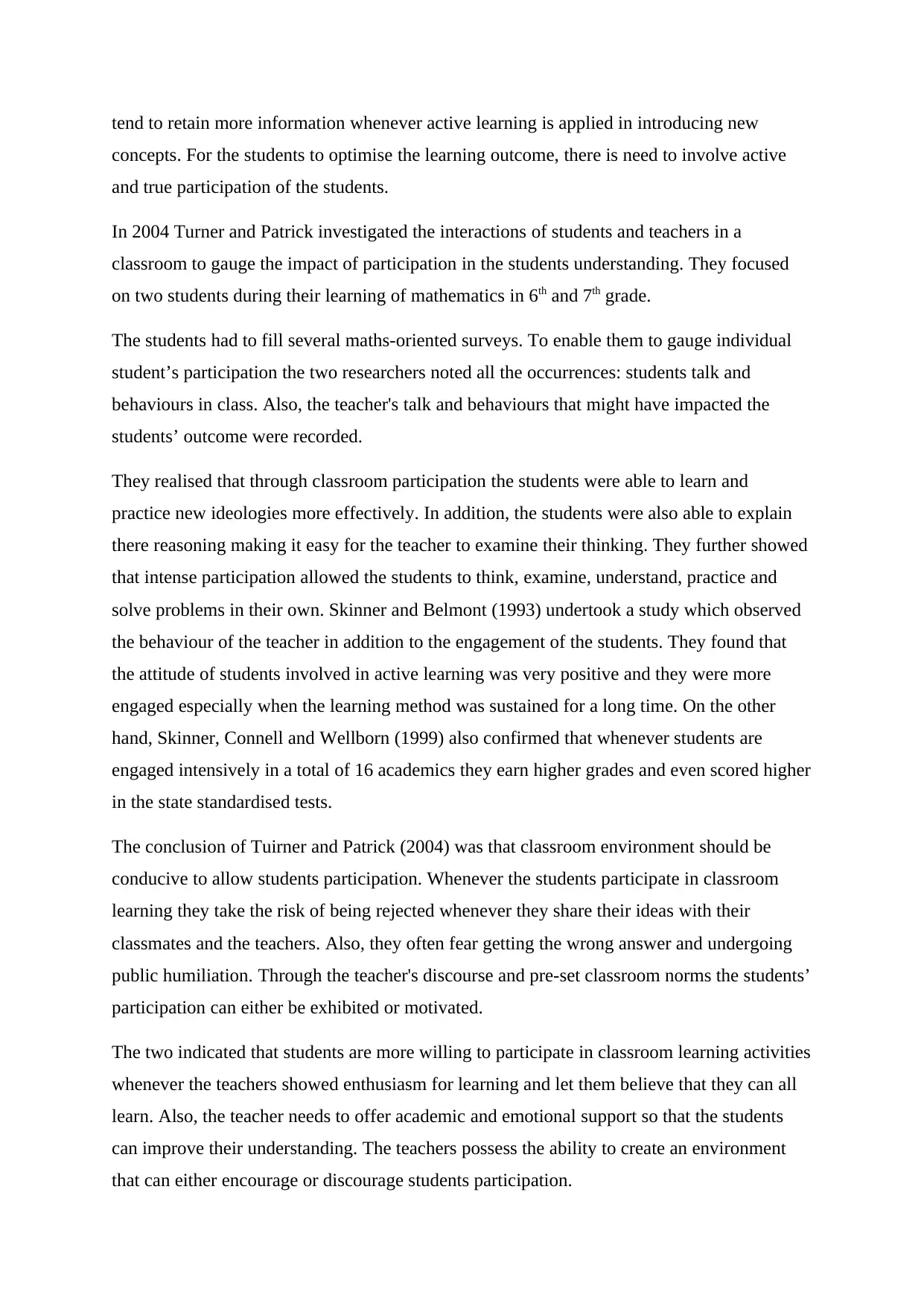
tend to retain more information whenever active learning is applied in introducing new
concepts. For the students to optimise the learning outcome, there is need to involve active
and true participation of the students.
In 2004 Turner and Patrick investigated the interactions of students and teachers in a
classroom to gauge the impact of participation in the students understanding. They focused
on two students during their learning of mathematics in 6th and 7th grade.
The students had to fill several maths-oriented surveys. To enable them to gauge individual
student’s participation the two researchers noted all the occurrences: students talk and
behaviours in class. Also, the teacher's talk and behaviours that might have impacted the
students’ outcome were recorded.
They realised that through classroom participation the students were able to learn and
practice new ideologies more effectively. In addition, the students were also able to explain
there reasoning making it easy for the teacher to examine their thinking. They further showed
that intense participation allowed the students to think, examine, understand, practice and
solve problems in their own. Skinner and Belmont (1993) undertook a study which observed
the behaviour of the teacher in addition to the engagement of the students. They found that
the attitude of students involved in active learning was very positive and they were more
engaged especially when the learning method was sustained for a long time. On the other
hand, Skinner, Connell and Wellborn (1999) also confirmed that whenever students are
engaged intensively in a total of 16 academics they earn higher grades and even scored higher
in the state standardised tests.
The conclusion of Tuirner and Patrick (2004) was that classroom environment should be
conducive to allow students participation. Whenever the students participate in classroom
learning they take the risk of being rejected whenever they share their ideas with their
classmates and the teachers. Also, they often fear getting the wrong answer and undergoing
public humiliation. Through the teacher's discourse and pre-set classroom norms the students’
participation can either be exhibited or motivated.
The two indicated that students are more willing to participate in classroom learning activities
whenever the teachers showed enthusiasm for learning and let them believe that they can all
learn. Also, the teacher needs to offer academic and emotional support so that the students
can improve their understanding. The teachers possess the ability to create an environment
that can either encourage or discourage students participation.
concepts. For the students to optimise the learning outcome, there is need to involve active
and true participation of the students.
In 2004 Turner and Patrick investigated the interactions of students and teachers in a
classroom to gauge the impact of participation in the students understanding. They focused
on two students during their learning of mathematics in 6th and 7th grade.
The students had to fill several maths-oriented surveys. To enable them to gauge individual
student’s participation the two researchers noted all the occurrences: students talk and
behaviours in class. Also, the teacher's talk and behaviours that might have impacted the
students’ outcome were recorded.
They realised that through classroom participation the students were able to learn and
practice new ideologies more effectively. In addition, the students were also able to explain
there reasoning making it easy for the teacher to examine their thinking. They further showed
that intense participation allowed the students to think, examine, understand, practice and
solve problems in their own. Skinner and Belmont (1993) undertook a study which observed
the behaviour of the teacher in addition to the engagement of the students. They found that
the attitude of students involved in active learning was very positive and they were more
engaged especially when the learning method was sustained for a long time. On the other
hand, Skinner, Connell and Wellborn (1999) also confirmed that whenever students are
engaged intensively in a total of 16 academics they earn higher grades and even scored higher
in the state standardised tests.
The conclusion of Tuirner and Patrick (2004) was that classroom environment should be
conducive to allow students participation. Whenever the students participate in classroom
learning they take the risk of being rejected whenever they share their ideas with their
classmates and the teachers. Also, they often fear getting the wrong answer and undergoing
public humiliation. Through the teacher's discourse and pre-set classroom norms the students’
participation can either be exhibited or motivated.
The two indicated that students are more willing to participate in classroom learning activities
whenever the teachers showed enthusiasm for learning and let them believe that they can all
learn. Also, the teacher needs to offer academic and emotional support so that the students
can improve their understanding. The teachers possess the ability to create an environment
that can either encourage or discourage students participation.
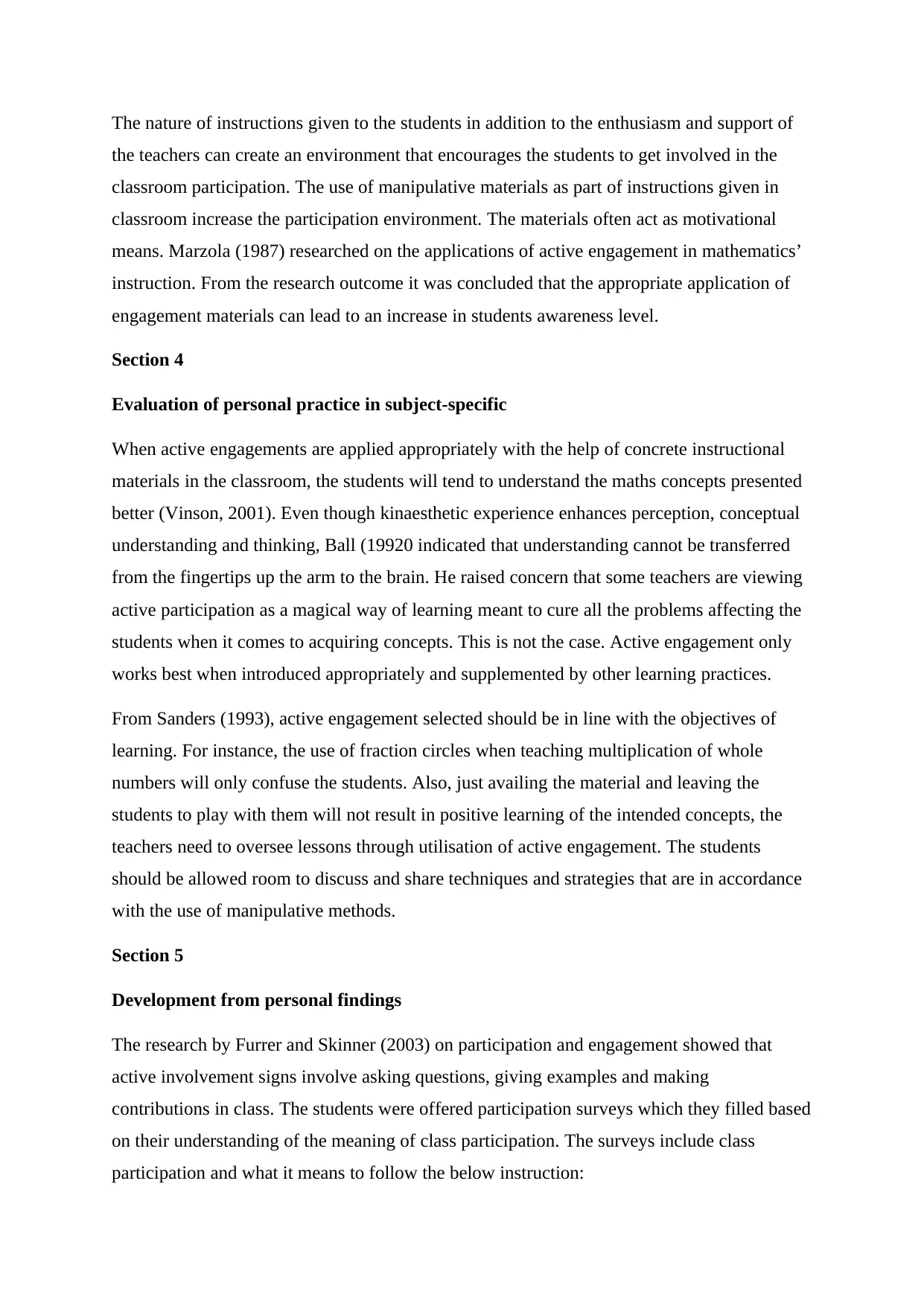
The nature of instructions given to the students in addition to the enthusiasm and support of
the teachers can create an environment that encourages the students to get involved in the
classroom participation. The use of manipulative materials as part of instructions given in
classroom increase the participation environment. The materials often act as motivational
means. Marzola (1987) researched on the applications of active engagement in mathematics’
instruction. From the research outcome it was concluded that the appropriate application of
engagement materials can lead to an increase in students awareness level.
Section 4
Evaluation of personal practice in subject-specific
When active engagements are applied appropriately with the help of concrete instructional
materials in the classroom, the students will tend to understand the maths concepts presented
better (Vinson, 2001). Even though kinaesthetic experience enhances perception, conceptual
understanding and thinking, Ball (19920 indicated that understanding cannot be transferred
from the fingertips up the arm to the brain. He raised concern that some teachers are viewing
active participation as a magical way of learning meant to cure all the problems affecting the
students when it comes to acquiring concepts. This is not the case. Active engagement only
works best when introduced appropriately and supplemented by other learning practices.
From Sanders (1993), active engagement selected should be in line with the objectives of
learning. For instance, the use of fraction circles when teaching multiplication of whole
numbers will only confuse the students. Also, just availing the material and leaving the
students to play with them will not result in positive learning of the intended concepts, the
teachers need to oversee lessons through utilisation of active engagement. The students
should be allowed room to discuss and share techniques and strategies that are in accordance
with the use of manipulative methods.
Section 5
Development from personal findings
The research by Furrer and Skinner (2003) on participation and engagement showed that
active involvement signs involve asking questions, giving examples and making
contributions in class. The students were offered participation surveys which they filled based
on their understanding of the meaning of class participation. The surveys include class
participation and what it means to follow the below instruction:
the teachers can create an environment that encourages the students to get involved in the
classroom participation. The use of manipulative materials as part of instructions given in
classroom increase the participation environment. The materials often act as motivational
means. Marzola (1987) researched on the applications of active engagement in mathematics’
instruction. From the research outcome it was concluded that the appropriate application of
engagement materials can lead to an increase in students awareness level.
Section 4
Evaluation of personal practice in subject-specific
When active engagements are applied appropriately with the help of concrete instructional
materials in the classroom, the students will tend to understand the maths concepts presented
better (Vinson, 2001). Even though kinaesthetic experience enhances perception, conceptual
understanding and thinking, Ball (19920 indicated that understanding cannot be transferred
from the fingertips up the arm to the brain. He raised concern that some teachers are viewing
active participation as a magical way of learning meant to cure all the problems affecting the
students when it comes to acquiring concepts. This is not the case. Active engagement only
works best when introduced appropriately and supplemented by other learning practices.
From Sanders (1993), active engagement selected should be in line with the objectives of
learning. For instance, the use of fraction circles when teaching multiplication of whole
numbers will only confuse the students. Also, just availing the material and leaving the
students to play with them will not result in positive learning of the intended concepts, the
teachers need to oversee lessons through utilisation of active engagement. The students
should be allowed room to discuss and share techniques and strategies that are in accordance
with the use of manipulative methods.
Section 5
Development from personal findings
The research by Furrer and Skinner (2003) on participation and engagement showed that
active involvement signs involve asking questions, giving examples and making
contributions in class. The students were offered participation surveys which they filled based
on their understanding of the meaning of class participation. The surveys include class
participation and what it means to follow the below instruction:
⊘ This is a preview!⊘
Do you want full access?
Subscribe today to unlock all pages.

Trusted by 1+ million students worldwide
1 out of 15
Your All-in-One AI-Powered Toolkit for Academic Success.
+13062052269
info@desklib.com
Available 24*7 on WhatsApp / Email
![[object Object]](/_next/static/media/star-bottom.7253800d.svg)
Unlock your academic potential
Copyright © 2020–2025 A2Z Services. All Rights Reserved. Developed and managed by ZUCOL.

